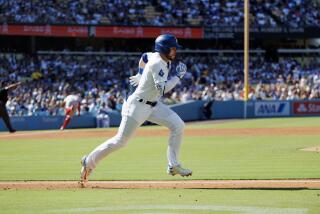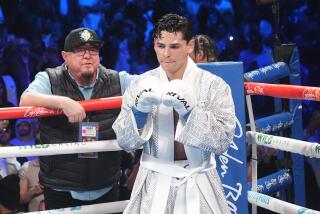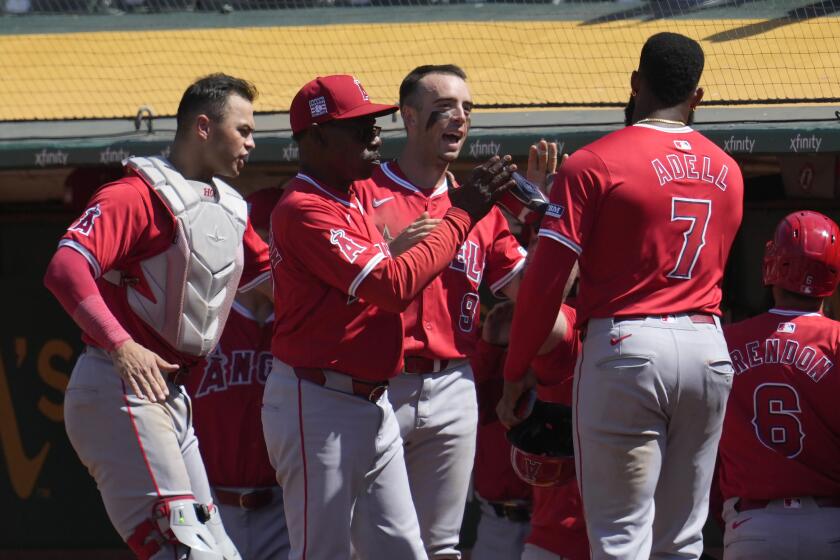Crash Kills Canadian Driver
Auto racing claimed another victim Sunday, the first at the 2-year-old California Speedway but the second this season in CART champ car racing and the third this year in Southern California.
Canadian driver Greg Moore was killed in a single-car accident described by fellow driver Alex Barron as “the most horrifying crash I’ve ever seen in front of me,” Barron adding, “I’ve never seen anything so violent.”
Moore’s crash was witnessed on national television, just as was that of Gonzalo Rodriguez, the rookie Uruguayan driver killed Sept. 12 in the CART race at Laguna Seca. It was witnessed by the California Speedway crowd of about 90,000.
Those who stayed until the end witnessed too, not the usual champagne-spraying ceremony on the winner’s stand, but instead a prayer service by chaplain Hunter Floyd of CART Ministries.
Those who stayed tuned to their TVs heard Chip Ganassi, whose first-year driver, Juan Montoya, had just given the car owner his fourth consecutive CART title say, “I’m not ready for the championship. I’m not ready for the day’s [championship] activities. Greg was a friend of all of us.”
Reporters at the track heard other drivers trying to talk through their tears. They heard officials from CART and California Speedway say all of the right, the human, the sensitive things, expressing their own sorrow, their sympathy for Moore’s family. They talked of how Moore represented all that is good in CART racing, of his competitiveness, his love for racing, the championships he surely was going to win. Then, when all of that was done, there was a moment of silence.
So what are we to make of this, a life lost in pursuit of sport? Another life lost in pursuit of sport.
Ah, if only there were an easy answer.
There are always knee-jerk responses to car-racing tragedies.
“Well no wonder they kill people, they’re going much too fast,” is an oft-heard refrain.
Yes, of course, they’re going too fast. Always have been, going back to the early part of this waning century, when 40 mph was too fast. Greg Moore was traveling in excess of 200 mph when his car betrayed him. But Casey Demert was doing only about 80 last spring when he rolled his sprint car in a fatal crash at Irwindale Speedway.
The late Bill France, the founder of NASCAR, used to say, “It isn’t how fast you go. It’s how fast you stop.”
Perhaps they are going too fast. The Indy Lights, which look a lot like champ cars but are about 50 mph slower, traditionally put on a better race at California Speedway than the champ cars do, at least partly because they aren’t going so fast. But Rodriguez was killed on a road course, where speeds are much slower than on the high-speed ovals. And CART--and the IRL and NASCAR--are conscious of the ever-increasing speeds and work to harness it, partly for safety, partly so people can actually see the cars as they race.
The track record at California Speedway, for instance, is 240.942 mph. Mauricio Gugelmin went that fast two years ago. After that, however, CART mandated the Handford Device to slow the champ cars on the high-speed tracks, the Michigan and California speedways. As a result, Scott Pruett, the fastest qualifier for Sunday’s race, reached only 235.398.
But the simple fact is, speed and racing are inseparable. In any race, from the three-legged race at the Cub Scout picnic to the Indianapolis 500, the idea is to get to the end first. And to do that, you have to be the fastest. Racing organizations can--and should--do all they can to keep cars from becoming supersonic missiles. But technology always catches up to technology, and trying to regulate speed on the racetrack is a lot like trying to regulate the sunrise.
One of the byproducts of speed on the high-speed tracks is wake turbulence. Running behind other cars can sometimes approximate rowing a shell behind a hydroplane. Before Moore’s accident, Richie Hearn lost control of his car just about where Moore would lose control of his, hitting the inside wall, as Moore would, but escaping injury. He blamed his accident on turbulence.
Did the same thing happen to Moore? Maybe. Probably. But we’ll never know for sure.
There was some question of Moore’s fitness to drive. He had broken a finger Saturday morning in a motor-scooter accident and was held out of qualifying. But, fitted with a hand brace, he was allowed a test drive after qualifying, passed it and said he wanted to drive in Sunday’s race, even if it meant starting at the back of the field.
Doctors said later that the break had not been a severe injury, that there never was much question about his fitness, that they had been more concerned that vibrations in the car might aggravate the injury. Other drivers have competed successfully with far more serious problems, they said.
Apparently, then, if there is any fault to be found on that score, it is with Moore’s own desire to drive. But how can anyone find fault with that? He was a driver.
So, again, what are we to make of this, a life lost in pursuit of sport?
It is a tragedy.
Just as it is a tragedy when a worker is killed in a construction accident. Or a young mom is killed in a traffic accident. Or dies of leukemia. Anyone’s death is a tragedy, regardless of the circumstances.
In this day and age of auto racing, we sometimes tend to forget that it is an extremely dangerous venture. We see it on TV all the time. We see cars hit the wall and fly into pieces, then watch as drivers walk away--as did Richie Hearn. We read about safety improvement, of cars built to dissipate the force of a hit, rather than absorb it, and we recall how, in years past, drivers were killed in far less serious-looking crashes. We marvel at how far the sport has come in protecting the people who practice it, how much safer it is now.
But racing is not safe. It will never be safe. If it were, men like Greg Moore would have nothing to do with it. They would find something else to do, something with an edge to it.
Moore’s death was a tragedy. It also was a simple accident. Accidents happen in racing. It’s unfortunate, sometimes in the extreme, as it was Sunday at California Speedway. But it’s also a simple truth, and that’s about all that can be made of it.
More to Read
Go beyond the scoreboard
Get the latest on L.A.'s teams in the daily Sports Report newsletter.
You may occasionally receive promotional content from the Los Angeles Times.






